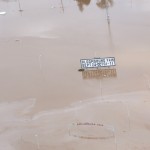Governor Tom Corbett on assistance available to those affected by flood waters in Pennsylvania
object width=”560″ height=”345″>
object width=”560″ height=”345″>
State Health officials are reminding people who’ve suffered flood damage to get their homes and businesses dried out as quickly as possible. Damp conditions can be a breeding ground for mold, and it can grow it as little as two days after flooding occurs.
Spokeswoman Christine Cronkright says porous materials can trap mold, so you should dispose of damaged items such as paper, ceiling tiles, wallboard, sheetrock, and carpeting.
You should clean and disinfect damp areas and keep them well ventilated, allowing them to dry naturally to kill all molds. Cronkright says make sure you protect yourself while cleaning moldy areas. This means wearing gloves, such as rubber dishwashing gloves and using a mask or respirator to minimize exposure.
Use non-ammonia soap or detergent or a commercial cleaner in hot water to clean flood-damaged areas. Disinfect with a solution of no more than one cup of bleach in one gallon of water. Never mix bleach with ammonia, because the fumes are toxic.
Cronkright says sheetrock should be removed to at least 12” above the high water mark. You should allow the area to dry for at least 2 to 3 days before replacing any damaged materials. Make sure you check all areas that may have become wet, including ceiling tiles and wallboard.
Don’t forget to document all of your flood damage before cleaning, taking photos of the damaged areas of your property.
Mold spores in large numbers can cause allergic reactions, asthma episodes, infections and other respiratory problems. People who are at higher risk from the effects of mold include infants and children, senior citizens, people with compromised immune systems, pregnant women and people with existing respiratory conditions.
For more information, resources and tips for clean up after floods, visit the department’s website and click on “PA Post-Flooding Information and Resources”.
The unofficial death toll stands at 12, according to Governor Tom Corbett’s latest briefing. “I believe though that a combination of planning, quick response by emergency responders throughout the affected region and the bravery of those emergency crews have prevented that number from going higher,” Corbett says. State officials estimate that more than 2,000 homes have been damaged.
The governor says the recovery phase of the flooding disaster will be long and difficult. “It’s going to be the coordination of the local, county, state and federal [governments]. Many people are going to be asking for help.”

The Bloomsburg Fairgrounds were overtaken by the Susquehanna River. Volunteers are now helping in a massive cleanup operation to get ready for opening day.
Some northeastern Pennsylvania residents haven’t even been able to get back into their homes to view the damage. “At the height there were 21-shelters open, there are still 16-shelters open,” explains Red Cross public affairs manager Janice Osborne. “Our primary role right now is to provide shelter for people, to provide food, and for the immediate emergency needs such as emotional counseling, toiletry items.”
The Red Cross is preparing and distributing 20,000 hot meals a day. Cleanup supplies are arriving by the truckload, but they still need your monetary help. Blood donations are also valuable, as Osborne says many of the blood donation collection sites had to close down due to the flooding.
The Department of Environmental Protection (DEP) is warning affected residents not to rush back into their homes, as they must be dried and thoroughly cleaned first. Everything the flood water touched should be disinfected, but many items – like mattresses and carpets – are better off in the dumpster.
Flooding continued along the Susquehanna River, but the water levels were dropping . The river reached record levels at Wilkes Barre and other points north. The levels at Harrisburg and Marietta were the highest since Agnes hit in 1972.
The river reached its high points at Harrisburg and Marietta on Friday. It reached 25.17 at Harrisburg Friday morning and should drop below flood stage later on Sunday. The river reached 58.16 feet at Marietta Friday morning and should drop below flood stage by Monday morning. The flooding displaced thousands of people and caused devastating damage to homes and businesses along the river.
Ben Pratt, Hydraulic Engineer with the Susquehanna River Basin Commission, says the risk of flash flooding could rise again along streams and creeks if any thunderstorms hit affected areas in the next few days. He says that’s because those tributaries are still swollen with the rain that fell from the remnants of Tropical Storm Lee.
Pratt says the Susquehanna should eventually get back to normal levels with little damage to the river. But in the short term, the quality of the water will continue to be affected as the flood flow works its way through the system.
Unofficial rainfall amounts posted by the National Weather Service for September 4-8 range from 3.28 inches in Renovo, Clinton County to 15.2 inches in Elizabethtown, Lancaster County. Dauphin County was also hit hard with totals ranging from 12 to nearly 14 inches and 14.7 inches was reported in Pine Grove, Schuylkill County.
Many towns had to deal with small stream and creek flooding followed by river flooding. In Goldsboro, York County, more than two dozen homes along the river were flooded. The swollen Susquehanna forced Fishing Creek to back up, closing two of the main roads into the river town. The water also nearly filled a railroad underpass, blocking access to several homes and campsites along the river.
People with summer homes on the islands nearby will have to wait until the river begins to go down and debris flow eases, before they can safely access their properties by boat. One man watched along the river Friday morning. He said he had gone to his property on Shelley Island earlier in the week and moved valuables above the 2004 Hurricane Ivan flood level, but after returning, the forecast added another 5 feet to the crest. He was relieved when the forecast was revised down to 25.2 feet at Harrisburg, just a little less than a foot higher than Ivan.
Humans weren’t the only ones affected in Goldsboro. As the water inundated back yards, a rooster and three hens took to the sidewalk when their coop was flooded.
It came close, but the Susquehanna River never quite reached the top of the 41-foot levies that protect the city of Wilkes-Barre. “The levee system worked pretty well. There are still some questions about it over time,” says Senator Bob Casey (D-PA), who toured the damage this morning with Senator Pat Toomey (R-PA). “The smaller communities that didn’t have that kind of protection – West Pittston comes to mind – they have very high water, sometimes as high as the second floor.”
Stress on the levee system is a top concern for Luzerne County Commission chair Maryanne Petrilla, but there are others. For instance: boils. “The ground is so saturated that the river water is going under the levee and coming up in… we call it a boil, if you can imagine water boiling outside the ground.” Local officials are combating the boils with truckloads of stone.
For now, some 65-thousand Wilkes-Barre area residents remain under evacuation orders. “We realize they want to come back home, but they just can’t, it’s not safe yet,” Petrilla stresses. Also, it’s too early to talk damage assessments. Petrilla says that will have to wait until next week.
Downriver in Dauphin County, the commissioners are already turning their attention to the recovery phase of emergency operations. “We have teams that are going to be going out looking at infrastructure. Starting Monday morning, the county’s engineering team will be looking at all of the bridges to make sure they are okay. We’ve been working with PennDOT for an assessment on our local roads,” Dauphin County Commission chair Jeff Haste said at a Friday afternoon briefing.
Haste says the recovery effort is going to be long, tedious and costly. He also urged residents to use caution as they come back to assess the damage. “Make sure the water has receded. The water that is out there is toxic water. Even when the water has gone down, there’s still going to be petroleum in there, there’s still going to be solid waste laying around.” Two wastewater treatment plants disappeared in the floodwaters this week.
Residents along the Susquehanna River had a busy morning Thursday, preparing as the water rose. In Goldsboro, York County, neighbors helped a man who recently had surgery move his possessions out of the basement. The wall by the window bore marks noting the floods that had hit the house before. But there wasn’t room for a mark for Agnes, because at that level, the water would reach his top floor.
Down the river at the railroad underpass, another man was watching the water rise. Water from Fishing Creek, backed up where it meets the Susquehanna River, had blocked the only road in. His campsite and boat were on the other side. A pizza shop nearby was closed as flood water crept closer to the building. People watching the rising water said if the flood hits levels predicted, it will sweep across the main road that leads into the borough.
It’s a Level One situation at the PEMA emergency operations center in suburban Harrisburg. That’s the highest level possible for a state disaster response. “By comparison, 11-days ago, Hurricane Irene only reached a Level Two here in Pennsylvania,” Governor Tom Corbett said at an afternoon media briefing from the PEMA headquarters. The last time the emergency operations center was operating at Level One was 9/11/01.

Gov. Corbett and PEMA director Glenn Cannon brief the media on the flooding in central and northeastern PA.
Governor Corbett says the state faces a clear public health emergency. “Sewage treatment plants, such as the one near Hershey, are underwater and no longer working,” Corbett says, “As you know flood water is toxic.” The governor’s message was clear: stay out of the flood water unless you are being rescued.
So far three deaths have been attributed to the flooding. Two of those deaths are in Lancaster County; the third is in Dauphin County, though PEMA director Glenn Cannon says they are as of yet unconfirmed. Almost every town along the Susquehanna River has experienced flooding, but the situation is expected to only get worse until the river crests.
By Friday morning, 1,200 National Guard troops will have been activated. 400 of them are already assisting in the evacuation and protection of thousands of Wilkes-Barre residents, who are evacuating low-lying areas. Governor Corbett has been in contact with federal officials, and says FEMA is flying in pallets full of water and MRE’s (meals, ready-to-eat). The supplies are being dropped off at Ft. Indiantown Gap, and will be distributed to the county level as needed.
Welcome to PAMatters.com, a new source for news and commentary from Pennsylvania’s capital. In addition to video, audio and pictures from the stories and events that affect YOU, you’ll also get some behind-the-scenes analysis via blogs from our award-winning staff of journalists.
